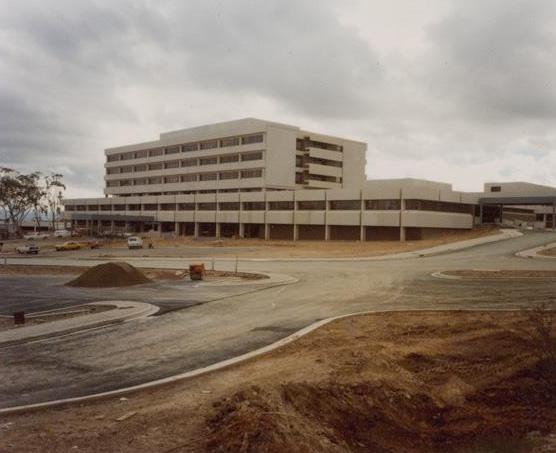
Canberra Community Hospital in 1935. Photo: National Archives of Australia.
Early last century, just after the Federal Capital Territory had been surveyed, before the Griffin plan was selected for the city’s design and before the city had even been named, the new capital (population 1777) needed a hospital.
The area had been well served by a 17-bed hospital in Queanbeyan. It had resident nurses and doctors tended the patients and ran their private practices.
By 1911 the Royal Military College, Duntroon (RMC) was nearing completion, ready for the first cadets. A workman’s camp was established nearby. Resident medical officer, Dr Peter Lalor, noted the need for medical care for the cadets. He asked the Department of Home Affairs, responsible for setting up the new capital, for a tent as a temporary hospital. This would deal with minor conditions while more serious cases would be referred to Queanbeyan Hospital.
The request for a 9 metre x 6-metre tent with timber floor, six beds, a washstand, two basins, a jug and a small cupboard was made. Also requested was “an intelligent man” to manage the hospital and cater for patients.
As the department deliberated this request, the threat of a pandemic saw rapid action after a workman presented with diphtheria symptoms.
Not one, but three tents (two spare – in case the pandemic took hold), were hurriedly dispatched by train from Sydney. The hospital tent was erected four days later. Drama was averted when the workman was fine, but this exercise highlighted the need for a permanent hospital.
Temporary wooden buildings for Canberra Community Hospital opened in 1914 with eight beds,in Balmain Crescent, Acton. Patients must have been a hardy lot in those days as tents continued to be used for additional wards when needed, particularly as isolation wards. You can imagine how cold these would have been in the depths of Canberra’s winters.
For the next 29 years, the original ‘temporary’ timber buildings continued to be used. Some of these are still used today by the Australian National University.
The first nurse appointed in the Territory, and to the hospital, was Miss Margaretta Charles-West, a highly experienced nursing sister. She would do her rounds travelling by horse and sulky.
After World War I, the building of the capital stalled, Canberra Community Hospital was running at a loss and was closed. Patients were treated once again by Queanbeyan Hospital.
RMC quickly took over Canberra Community Hospital to care for German internees from the Molonglo internment camp located where Fyshwick now stands.
The ‘Spanish flu’ pandemic in 1921 prompted the government to reopen Canberra Community Hospital as an isolation facility.
In 1928, the hospital became a training school, with additional wards and X-ray and outpatient departments. Tents were no longer needed.
The brick hospital was built in 1942 and was used by the United States Army Medical Corps, caring for sick and injured personnel transported from service in the Pacific. This proved impractical, and the Canberra Hospital Board took over the new building in 1943.
In 1979 Canberra Community Hospital became known as Royal Canberra Hospital. Many Canberrans have memories of this hospital, the nurses’ training facilities, the peaceful surroundings and tranquil views across the lake.
A tall pine tree with a bulge on one side grew near the maternity wing. Known as the ‘pregnant pine’ for its shape, it can still be seen on the site today.

Canberra Community Hospital and nursing home, in 1978. Photo: National Archives of Australia.
Canberra Community Hospital was the only public hospital in Canberra until Woden Valley Hospital opened in 1973. By this time, Canberra was expanding with the developments of the Woden Valley and Belconnen satellite cities. Canberra’s population had grown to 172,000.
Royal Canberra Hospital closed in November 1991 when it amalgamated with Woden Valley Hospital.
From July 1996, the amalgamated hospitals became known as Canberra Hospital, located on the Woden Valley Hospital site in Garran.
The main Acton building was imploded on 13 July 1997. Removing the hospital from this site still evokes discussion and strong opinion today. The tragic death of a young onlooker is also well remembered. The site is now home to the National Museum of Australia. Before it was built, a smoke-cleansing ceremony was held by local Ngunnawal people, allowing the spirits of those that died at the hospital to depart and provide a clean start for the future.
Calvary Hospital in Bruce opened in 1979, run by the Little Company of Mary. It is part of a national network of 14 public and private hospitals, 72 residential care and retirement communities, 19 community care service centres, and has more than 18,000 staff and volunteers. Calvary is a Catholic not-for-profit organisation run by Calvary Health Care.

Calvary Hospital under construction in 1978. Photo: National Archives of Australia.
A teaching hospital, Calvary is associated with the Australian Catholic University, the Australian National University and the University of Canberra.
The recent announcement by the ACT Government to take over the Calvary Hospital site to build a new hospital took many by surprise and has created much debate.
What happens next, history will tell.
Original Article published by Marg Wade on Riotact.


